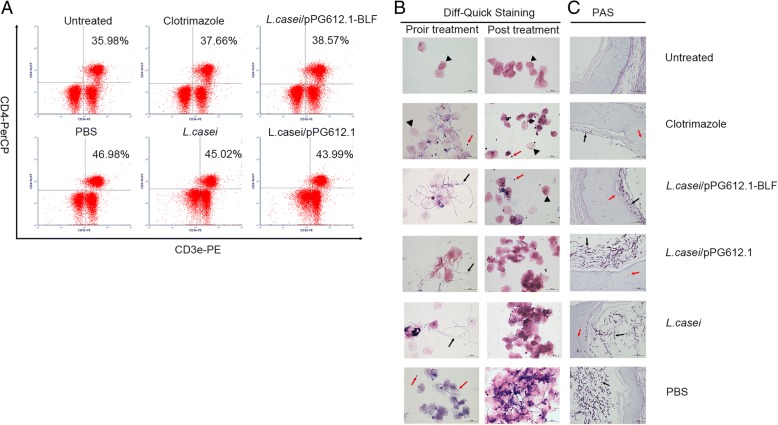Fig. 6.
Cytological analysis of lumbar lymph nodes and histological analysis of vagina tissue in murine VVC model after treatment with L.casei/pPG612.1-BLF. a The change in the percentage of CD4+ T cells in murine lymph nodes were evaluated by dual-colour flow cytometric analysis. Lumbar lymph nodes were isolated immediately after sacrifice to make single-cell suspension at 106cell/mL. Phycoerythrin (PE) -labelled anti-mouse CD3 and peridinin Chlorophyll Protein Complex (PerCP)-labelled anti-mouse CD4 antibodies simultaneously were added to the samples at a concentration of 0.25 μg/106 cells. In the PBS group, the percentage of CD4+ T cells in the murine lumbar lymph nodes was 48.09 ± 3.53%; it was 46.93 ± 2.42% in L. casei group and 45.55 ± 2.07% in the L. casei/pPG612.1 group, and was higher (P = 0.04) than in the L. casei/pPG612.1-BLF group (39.34 ± 1.34%) and clotrimazole group (38.65 ± 1.94%). b Vaginal cast-off cells in lavage was processed with Diff-Quick Staining prior and post treatment in murine VVC model. Heat-fixed lavage smears were dip into the StainIfor 15 s, and successively into Stain II for another 15 s, followed by rinsed rapidly in tap water. Post-infection with fungi (prior treatment), many filamentous pseudohyphae (violet) and cornified squamous epithelial cells (pink) were apparent in each sample. Post 5-day treatment, fewer epithelial cells were apparent in samples from mice which were given L.casei/pPG612.1-BLF or 20 mg/mL clotrimazole, with several neutrophils (red arrow) and no filamentous pseudohyphae. In contrast, in samples from mice receiving L.casei/pPG612.1 or L.casei or PBS, copious numbers of epithelial cells were observed with filamentous pseudohyphae (PBS group) or without filamentous pseudohyphae (L. casei/pPG612.1 and L. casei groups). c The vagina tissue was extracted following sacrifice post 5-day treatment, fixed in 10% neutral-buffered formalin and embedded in paraffin. The 3-to 4-μm–thick sections from every mouse were mounted on a poly-l-lysine–coated slide and stained with hematoxylin, eosin and periodic-acid/Schiff’s reagent. Much fewer pseudohyphae (black arrow) and blastoconidia adhering to the cornified epithelial layer were observed in samples from mice which were given treatment with L.casei/pPG612.1-BLF or 20 mg/mL clotrimazole, in comparison with that from groups which received L.casei/pPG612.1, L.casei or PBS. Additionally, samples from L.casei/pPG612.1 and L.casei groups showed fewer pseudohyphae and blastoconidia in the vaginal cavity than those in the PBS group. Besides, infiltration of neutrophil (red arrow) into the mucosal layer were observed in infected mice. Scale bars, 50 μm (b), 50 μm (c)

